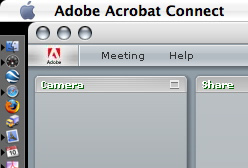Out with the Breeze, in with the Acrobat


If you aren't familiar with Breeze, it is a collaboration and online meeting tool. More importantly, I've always felt that Breeze is one of the most intriguing applications in Adobe's stable. It was collaboration and web conferencing done in the easiest way possible. If you had the Flash Player installed, you were up and running, connected to your peers and ready to hold a conference complete with audio and video. What intrigued me so much is that the entire application was built on the Flash Platform. It gave a glimpse into the kinds of things that the Flash Player was really capable of, and what you could accomplish if you were intimately familiar with the innards of the player. In a sense, it was a snapshot of what the web could look like down the road - easy, sophisticated, real-time collaboration - all courtesy of Flash.
Unfortunately, most of the world never saw Breeze. It was expensive, even as a hosted solution, and unless you were in a big corporation that used it, the only time you could take advantage of it was when Adobe held web seminars, and that audience was fairly small.
Now, with the new Adobe Acrobat Connect, one of the most interesting products from Macromedia has become part of Adobe's most important product. It is also an example of why Macromedia and Adobe were such a good fit. Adobe has traditionally been very strong in enterprise solutions. Through Acrobat, they were able to establish a document workflow platform that fit very well in an enterprise environment. But document workflow alone simply wasn't enough, and now they've incorporated Breeze into the Acrobat family for a significant value add.
So what does this mean for both Breeze and Adobe? It will be interesting to see how many companies embrace the new Acrobat platform. Collaboration on the web is still very young in terms of actual implementation, and adoption can only go up. Breeze was such an elegant solution because of its simplicity - all you needed was the Flash Player. If that simplicity can use the Acrobat name to gain some widespread acceptance among big companies, Adobe will have a gem of a Rich Internet Application.